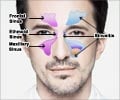Researchers have developed a new set of clinical decision rules such as a point score and algorithm, which act as reference standards for diagnosing sinusitis.

‘The clinical decision rule helps in identifying patients at low risk for a bacterial infection, and aids in prescribing appropriate antibiotics.’





The point score using this reference standard successfully identified groups with a low (16 percent), moderate (49 percent) and high (73 percent) likelihood of acute bacterial rhinosinusitis. By identifying patients at low risk for a bacterial infection, this clinical decision rule can lead to more conservative use of antibiotics and help reduce inappropriate antibiotic prescribing.
According to the authors, prospective validation of the findings and an assessment of their effect on clinical and process outcomes are important next steps.
Source-Eurekalert














